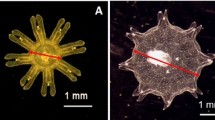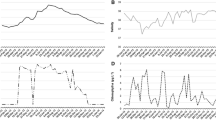Abstract
Copepods of the genusEurytemora, isolated from the Patuxent River, a tributary of Chesapeake Bay, were fed suspensions of the ciliateUronema isolated from the Rhode River, a subestuary of Chesapeake Bay. Grazing by copepods was determined by the decrease in numbers of ciliates, which were monitored by both direct counting and particle size analysis. Results from both methods of analysis showed significant reduction in the numbers ofUronema in the suspension whenEurytemora was present. Survival of copepods with ciliates added as food source was significantly longer than without ciliates. Analysis of field samples collected in the fall showed that ciliates comprised approximately 20% of the total plankton biomass at selected sampling sites. The results of the laboratory and field studies indicate that copepods can feed on ciliates and suggest that, in nature, ciliates may comprise an important source of food for copepods.
Similar content being viewed by others
References
J. D. Allan, T. G. Kinsey, and M. C. James, Abundances and production of copepods in the Rhode River subestuary of Chesapeake Bay,Chesapeake Sci. 17 (1976), 86–92.
J. R. Beers and G. L. Stewart, Micro-zooplankton in the euphotic zone at five locations across the California Current,Fish. Res. Bd. Can. 24 (1967), 2053–2068.
J. R. Beers and G. L. Stewart, Micro-zooplankton and its abundance relative to the larger Zooplankton and other seston components,Mar. Biol. 4 (1969), 182–189.
J. R. Beers and G. L. Stewart, The ecology of the plankton off La Jolla, California in the period April through September 1967. Part VI. Numerical abundance and estimated biomass of microzooplankton,Bull. Scripps Inst. Oceanogr. 17 (1970), 67–87.
S. G. Berk, R. R. Colwell, and E. B. Small, A Study of feeding responses to bacterial prey by estuarine ciliates,Trans. Am. Micros. Soc. 95 (1976), 514–520.
C. M. Boyd, Selection of particle sizes by filter-feeding copepods: A plea for reason,Limnol. Oceanogr. 21 (1976), 175–180.
R. J. Conover, Feeding on large particles byCalanus hyperboreus. In:Some Contemporary Studies in Marine Science, edited by H. Barnes, pp. 187–194. Halfner Publishing Co., New York, 1966.
C. R. Curds and A. Cockburn. Studies on the growth and feeding ofTetrahymena pyriformis in axenic and monoxenic culture,J. Gen. Microbiol. 54 (1968), 343–358.
S. K. Eltringham, Life in mud and sand, English University Press Ltd., London, 1971.
B. W. Frost, Effects of size and concentration of food particles on the feeding behavior of the marine planktonic copepodCalanus pacificus, Limnol. Oceanogr. 17 (1972), 805–815.
D. T. Gauld, Grazing rate of planktonic copepods,J. Mar. Biol. Assoc. 29 (1951), 695–706.
M. Gillbricht, Das Verhalten von Zooplankton-vorzugsweise vonTintinnopsis beroidea Entzgegenuber thermohalinen Sprungsichten,Kurtz. Mitt. Inst. Fisch. Biol. Univ. Hamb. 5 (1954), 32–44.
K. Gold, Growth characteristics of the mass-reared tintinnidTintinnopsis beroidea, Mar. Biol. 8 (1971), 105–108.
R. D. Hamilton and J. E. Preslan, Cultural characteristics of a pelagic marine hymenostome ciliate,Uronema sp.,J. Exp. Mar. Biol. Ecol. 4 (1969), 90–99.
H. Hedin, On the ecology of tintinnids on the Swedish west coast,Zoon. 3 (1975), 125–140.
D. R. Heinle, Production of a calanoid copepod,Acartia tonsa, in the Patuxent River estuary,Chesapeake Sci. 7 (1966), 59–74.
D. R. Heinle and D. A. Flemer, Carbon requirements of a population of the estuarine copepodEurytemora affinis, Mar. Biol. 31 (1975), 235–247.
D. R. Heinle, R. P. Harris, J. F. Ustach, and D. A. Flemer, Detritus as food for estuarine copepods,Mar. Biol. 40 (1977), 341–353.
J. Lippson, (Ed.),The Chesapeake Bay in Maryland. Johns Hopkins University Press, Baltimore, 1973.
M. M. Mullin, Selective feeding by calanoid copepods from the Indian Ocean. In:Some Contemporary Studies in Marine Science, edited by H. Barnes, pp. 545–554. Halfner Publishing Co., New York, 1966.
A. Nauwreck, Die Beziehungen zwischen Zooplankton und Phytoplankton im See Erken,Symb. Bot. Upsal. 17 (1963), 163 p.
P. Nival and S. Nival, Particle retention efficiencies of an herbivorous copepod,Acartia clausi (adult and copepodite stages): Effects on grazing,Limnol. Oceanogr. 21 (1976), 24–38.
G.-A. Paffenhöfer, Feeding, growth, and food conversion of the marine planktonic copepodCalanus helgolandicus, Limnol. Oceanogr. 21 (1976), 39–50.
K. G. Porter, Selective grazing and differential digestion of algae by Zooplankton,Nature 244 (1973), 179–180.
S. A. Poulet, Grazing ofPseudocalanus minutus on naturally occurring particulate matter,Limnol. Oceanogr. 18 (1973), 564–573.
G. Proper and J. C. Garver, Mass culture of the protozoaColpoda steinii, Biotech. Bioeng. 8 (1966), 287–296.
S. Richman and J. N. Rogers, Feeding ofCalanus helgolandicus on synchronously growing populations of the marine diatomDitylum brightwellii, Limnol. Oceanogr. 14 (1969), 701–709.
F. H. Rigler, Laboratory measurements of processes involved in secondary production. 2. Feeding rates: Zooplankton. In:Secondary Productivity in Fresh Waters, edited by W. T. Edmondson and G. G. Winberg, pp. 228–256. IBT Handbook No. 17. Blackwell Scientific Publications, Oxford, 1971.
F. H. Rigler, M. E. MacCallum, and J. C. Roff, Production of Zooplankton in Char Lake,J. Fish Res. Bd. Can. 31 (1974), 637–646.
P. Vitiello, Contribution a l'etude des tintinnides de la baie d'Alger,Pelagos 2 (1964), 5–42.
R. A. Vollenweider, The scientific basis of lake and stream eutrophication, with particular reference to phosphorus and nitrogen as eutrophication factors,Tech. Rep. O.E.C.D. Paris Das/ CSI/6827 (1968), 1–182.
D. S. Wilson, Food size selection among copepods,Ecology 54 (1973), 909–914.
B. Zeitzschel, Tintinnen des westlichen Arabischen Meeres, ihre Bedeutung als Indikatoren fur Wasserkorper und Glied der Nahrungskette,“Meteor” Gorschungsergebnisse, D. Biologie (1969), 47–101.
Author information
Authors and Affiliations
Rights and permissions
About this article
Cite this article
Berk, S.G., Brownlee, D.C., Heinle, D.R. et al. Ciliates as a food source for marine planktonic copepods. Microb Ecol 4, 27–40 (1977). https://doi.org/10.1007/BF02010427
Issue Date:
DOI: https://doi.org/10.1007/BF02010427




